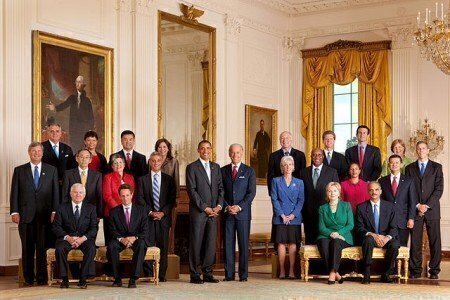Our Constitution covers many matters related to our government, but the nomination and approval process for the President’s cabinet wasn’t defined in great detail by the Founders.

The Constitution, in Article II, Section 2, says that the President “shall nominate, and by and with the Advice and Consent of the Senate, shall appoint Ambassadors, other public Ministers and Consuls, Judges of the Supreme Court, and all other Officers of the United States, whose Appointments are not herein otherwise provided for.”
The Appointments Clause allows the President to make nominations for appointed positions like cabinet officers, but the Senate controls the process, including the rules that allow a nomination vote to get to the full Senate floor.
If the Senate isn’t officially in session, the President does have the power to appoint officers directly using his recess appointments powers, but modern parliamentary techniques used in the Senate rarely allow an opportunity for such appointments.
There is little doubt that the direct nomination and approval of cabinet officials falls under the Appointments Clause while the Senate is in session. In the 1st Congress, President George Washington nominated Alexander Hamilton, John Jay, and Henry Knox to his first cabinet, and the Senate approved the nominations by a simple majority vote. Since then, the Senate has been the gatekeeper of cabinet approvals.
The Senate website has a detailed history of the various nomination processes since 1789. It was Washington who established the precedent that the President would inform the Senate of his choices after he made them, and not officially ask for “consent” prior to the nominations.
The Senate didn’t have issues with rejecting lower-level nominations early on in the 1st Congress. In August 1789, it rejected Washington’s nomination of Benjamin Fishbourn to the post of naval officer for the Port of Savannah. The spat between Washington and the Senate over Fishbourn led to the Senate agreeing to record its nomination votes; it had intended to take nomination votes in secret.
The first high-profile cabinet rejection by the Senate was in 1834, when President Andrew Jackson lost a fight to get Attorney General Roger Taney named as treasury secretary, in the bitter contest over the Second Bank of the United States. The Senate rejected Taney’s nomination by a 18-28 vote, but a determined Jackson was able to get Taney appointed as the Supreme Court’s chief justice in 1835 when his Democratic party had a slim Senate majority.
Since Taney’s rejection, it has been a rare occasion for cabinet officers to have their nominations rejected in a full Senate vote. Senate records show that only nine Cabinet nominees have been rejected once their nomination made it to a full floor vote.
The last major cabinet rejection was related to John Tower in 1989. Tower had headed the Senate Armed Services Committee until he retired in 1985. President George H.W. Bush had nominated Tower as defense secretary. The public debate over Tower’s nomination included a lot of mudslinging, and Tower lost the vote along party lines in the Democrat-controlled Senate. He was the only former Senate member rejected for a cabinet position by the Senate in its history. Dick Cheney was later approved in Tower’s place.
Another 12 cabinet nominations have been withdrawn during the process in the Senate or didn’t proceed due to Senate inaction. Most recently, the nomination of Tom Daschle by President Barack Obama was withdrawn in February 2009 for the position of Secretary of Health & Human Services.
In all, there have been more than 500 cabinet nominations considered by the Senate since 1789, so the success rate of cabinet nominees in the Senate has been very high.







